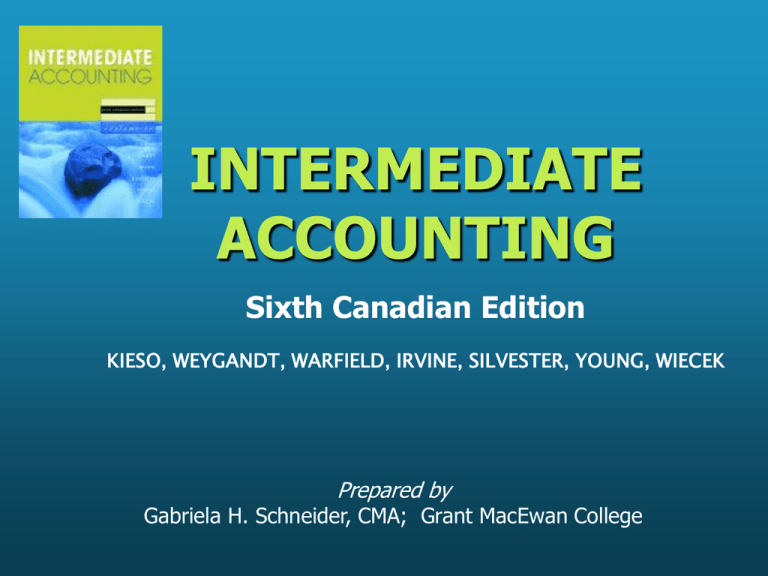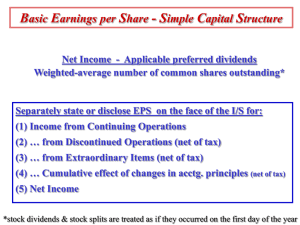
INTERMEDIATE
ACCOUNTING
Sixth Canadian Edition
KIESO, WEYGANDT, WARFIELD, IRVINE, SILVESTER, YOUNG, WIECEK
Prepared by
Gabriela H. Schneider, CMA; Grant MacEwan College
CHAPTER
18
Dilutive Securities and
Earnings Per Share
Learning Objectives
1. Describe the accounting for issuance,
conversion, and retirement of convertible
securities.
2. Explain the accounting for convertible
preferred shares.
3. Contrast the accounting for stock warrants
and stock warrants issued with other
securities.
Learning Objectives
4. Describe the accounting for stock
compensation plans under GAAP.
5. Explain the controversy involving stock
compensation plans.
6. Calculate earnings per share in a simple
capital structure.
7. Calculate earnings per share in a complex
capital structure.
Dilutive Securities and
Earnings Per Share
Dilutive Securities and
Compensation Plans
Convertible debt
Convertible preferred shares
Stock warrants
Stock compensation plans
Disclosure
Computing
Earnings per share
Simple capital
structure
Complex capital
structure
Dilutive Securities
• Instrument entitling holder to obtain
common shares
• When exercised cause existing
shareholder interest to dilute
• Ownership interest (percentage) impact
• Impact on EPS
• A.k.a. potential common shares
Convertible Debt
• Bonds that are convertible to other forms of
securities (e.g. common shares) during a
specified period of time
• Combines the benefits of a bond (interest
payments, principal repayment) with the
privilege of exchanging the bond for shares at
the bondholders option
• Once the bond is converted, all interest
payments and principal are no longer payable
Convertible Debt
•
Issued for two main reasons
1. Corporation can raise equity capital without
giving up ownership control
2. It can also achieve equity financing at a lower
cost
•
•
Conversion feature allows the corporation to offer
the bond issue at a lower coupon or stated rate
Conversion feature provides investor with an
opportunity to own equity. This feature generally
results in the investor accepting a lower coupon
rate than they would with non-convertible debt
Convertible Debt –
Accounting Issues
•
The reporting of convertible debt and
the conversion feature result in three
issues:
1. Reporting at the time of issuance
2. Reporting at the time of conversion
3. Reporting at the time of retirement
Reporting at the
Time of Issuance
• On issue date, part of the proceeds are
allocated to liability and part to equity
• This reflects the nature of the security –
since a convertible debt is part liability
and part equity
• The amounts allocated to liability and
equity are determined by using either:
• The Incremental Method
• The Proportional Method
The Incremental Method
• The value of the most easily measured
component is determined and allocated
to that component
• Debt generally the easier component to
value
• Remainder of the proceeds become the
value of the other component
The Incremental Method Example
Given:
$20,000,000 par value, 10% convertible bonds
issued at 99
If the bonds were not convertible, it is
estimated they would have been sold at 95
Bond issue costs were $70,000
What portion of the proceeds are allocated to Bond
Liability, and what portion to equity?
The Incremental Method Example
Total proceeds for the bond issue
($20,000,000 * .99)
=
$19,800,000
conversion option ($20,000,000 * .95) =
$19,000,000
Residual allocated to option
$
Fair value of the liability without the
Cash
Discount on Bond
Bonds Payable
=
800,000
19,800,000
1,000,000
20,000,000
Contributed Surplus – Stock Options
800,000
The Proportional Method
• When values for both the liability and
equity components are known or
determinable
• The Bond Discount (or Premium)
becomes a calculated amount under the
Proportional Method
The Proportional Method
Given:
• $10,000,000 of 8% convertible debentures due
in 20 years issued for $10,800,000
• Market value of the company’s common shares
(on issue date) $80 per share
• Present value of bonds at time of issuance was
$8,500,000
• Corporation believed the difference between
the present value and the amount paid was
attributable to the conversion feature
The Proportional Method
Present value (fair value) of the bonds
$8,500,000
Fair value of conversion rights
(10,800,000 – 8,500,000)
Cash
$2,300,000
10,800,000
Discount on Bonds Payable
Bonds Payable
Contributed Surplus
1,500,000
10,000,000
2,300,000
Note that in this case we are clearly given the fair
values for both the liability and the conversion feature
Reporting at Time of Conversion
• Main issue is determining the amount at
which to record the securities which are
being exchanged
• Two approaches available
• Market value approach
• Gain or loss on conversion can occur
• Book value approach
• Gain or loss on conversion does not occur
• Most common approach
• Either method acceptable under GAAP
Book Value Approach
• When market price of bonds or shares not
known
• Book Value of the bonds and conversion rights used
to record the conversion
• The basis for this method is that a “swap” or
exchange of security has taken place
• The values were established when the bonds
were originally issued and therefore should not
be changed, as there was a contract in place
Induced Conversion
• When the corporation wants to entice
or induce the bondholders to convert
their bonds into shares
• Additional consideration – the
“sweetener” – offered to the
bondholders to convert (cash, common
shares, etc.)
• The inducement is recorded as an
expense in the period of conversion
Reporting at the
Time of Retirement
• Treated the same as debt retirement
from Chapter 15
• Clear any outstanding premiums,
discounts, bond issue costs, interest
accrued to bondholders
• The conversion rights account must be
reallocated
• Equity components remains in Contributed
Surplus
Convertible Preferred Shares
• Convertible preferred shares are considered
equity
• Convertible debt considered liability and equity
• At the time of issuance no allocation between
debt and equity components
• Exception is redeemable preferred shares
• When conversion occurs the book value
method is always used
• Deemed the exchange of one equity for another
equity instrument
Stock Warrants
• Entitle the (share)holder to acquire shares
at a specified price, within a specified
period of time
• Attached to senior securities (bonds,
preferred shares)
• Difference between convertibles and
warrants
• With warrants the holder must pay an
amount of money in order to acquire the
shares
Stock Warrants
•
Warrants (options to purchase additional
shares) occur under three scenarios
1. To make the original security more
attractive to the investor
2. To provide evidence of the pre-emptive
right to acquire more common shares
3. Used as compensation for executives and
employees
Stock Warrants
• “Rights” are similar to warrants except that
rights have a shorter lifespan and are
attached only to common shares, in order to
purchase more common shares
• No journal entry required when rights are issued
• Use either the proportional or incremental
method of accounting when dealing with
detachable stock warrants
• If warrants are non-detachable, no allocation
to warrants is needed
Stock Compensation Plans
•
•
•
A form of stock warrant — a stock option
Provides the employee with an opportunity to
purchase shares at a given price, within a
specified period of time
Two accounting issues associated with stock
compensation plans
1. Determination of compensation expense
2. Periods of allocation for compensation expense
amounts
Stock Options - Important Dates
Work
start date
Grant
date
Vesting
date
Exercise
date
Expiration
date
Options
are
granted to
employee
Date that
employee
can first
exercise
options
Employee
exercises
options
Unexercised
options
expire
Compensation Cost
Measurement
•
Two available methods
1. Intrinsic Value Method
•
•
Excess of market price over exercise price at grant date
Requires expanded note disclosure
– Pro-forma net income and EPS under fair value
method
2. Fair Value Method
•
•
•
Measured at fair value of the stock options granted
Preferred method of measurement
Either method acceptable under GAAP, based
on newly developed and accepted standard
The Measurement Date
Compensation expense is determined as of
Measurement date (usually the grant date)
Measurement date
is:
Grant date - if both the
number of shares offered
and option price are known
Exercise date - if facts
depend on events after
grant date
Options: Allocating
Compensation Expense
Compensation Expense
is determined as of the
measurement date
and is allocated over
the service period
• The service period is the period benefited by
employee’s service
• It is usually the period between the grant date
and the vesting date
Compensation Expense - Example
Given:
5 Stock options granted January 1, 2001
Option to purchase:
2,000 shares each
Option price per share:
$60.00
Market price per share:
$70.00 (at grant date)
Stock option expires:
10 years
Service period:
2 years
Intrinsic Value Method:
Market value at grant date (5*2,000)*$70 = $700,000
Option price at grant date (5*2,000)*$60 = 600,000
Compensation expense
$100,000
Fair Value Method:
Expense calculated by applying an option pricing model
Compensation Expense – Example:
Journal Entries
Intrinsic Value
Fair Value
Grant Date
No Entry
December 31, 2001
Compensation Expense
50,000
Contributed Surplus–Stock Options
50,000
(100,000 2 years) // (220,000 2 years)
December 31, 2002
Compensation Expense
50,000
Contributed Surplus–Stock Options
50,000
No Entry
110,000
110,000
110,000
110,000
EPS - Simple Capital Structure
Net Income – Preferred Dividends
Weighted Average # of Shares Outstanding
• If the preferred shares are non-cumulative
• include only declared dividends
• If the preferred shares are cumulative
• include only declared dividends, or
• if no dividends declared, include only one
year’s dividends
EPS - Simple Capital Structure
• Weighted average number of common
shares outstanding
• To find the equivalent number of whole shares
outstanding for the year
• Stock splits and stock dividends require
restatement of the outstanding number of
shares from the beginning of the year
• Because there has been no change in the
company’s assets, or in the shareholders’ total
investment
EPS - Simple Capital Structure
• A final note (CICA Handbook, Section 3500)
• If there is a stock split or stock dividend
after the year end but before the
publication of the financial statements
• The weighted average number of shares
outstanding must be restated
• This applies to the current year, as well as
previous years if comparative statements are
issued
EPS Calculation Simple Capital Structure
Given:
January 1:
March 1:
June 1:
500,000 shares outstanding
Issued 20,000 shares
50% Stock dividend (60,000
November 1:
December 31:
Issued 30,000 shares
Ending Balance = 210,000
shares outstanding
additional shares issued)
Determine the weighted average number of shares
outstanding.
EPS Calculation Simple Capital Structure
Dates
O/S
Shares
O/S
Restatement
Fraction
of Year
Weighted
Shares
Jan-Mar 100,000 x
1.50
x
2/12 =
25,000
Mar-Jun 120,000 x
1.50
x
3/12 =
45,000
Jun-Nov 180,000
x
5/12 =
75,000
Nov-Dec 210,000
x
2/12 =
35,000
Weighted average shares outstanding
180,000
Complex Capital Structure
• Complex capital structure:
• When corporation has convertible securities, options,
warrants or other rights, and
• When converted these could dilute EPS
• Dilution is the reduction in EPS, if:
• securities, potentially convertible into common stock,
are converted [assumed at beginning of the year]
• Anti-dilutive securities
• Securities, when converted, increase EPS
• Anti-dilutive EPS are not reported, only basic EPS
EPS - Complex Capital Structure
• Requires dual presentation of EPS
• Basic earnings per share
• Presented for each separate class of
common share
• Fully diluted earnings per share
• Only securities that reduce earnings per
share (dilutive) are considered
• Securities that increase earnings per share
(anti-dilutive) are ignored
Diluted Earnings per Share Methods
• The dilutive effect of convertible securities is
measured by the if-converted method
• The dilutive effect of options and warrants is
measured by the treasury stock method
• For computing dilution, the rate of conversion
most advantageous to the security holder is
used (maximum dilutive conversion rate)
The If-Converted Method
• The conversion of the securities into common
stock is assumed to occur at the beginning of
the year
• The net income must be adjusted for:
• Interest (net of tax) on the convertible debt
• Dividends on the convertible preferred shares
• The weighted average number of shares is
increased by the additional common shares
assumed issued (at the beginning of year)
The Treasury Stock Method
• Options and warrants (and their equivalents)
are included in EPS computations
• Options and warrants are assumed exercised
at the beginning of the year
• The proceeds from the exercise of options are
assumed to be used to buy back common
shares
• The exercise price per share must be less
than the market price per share for dilution to
occur
Options and Warrants Treasury Stock Method
Given:
Exercise price of an option - [for one share of stock] $ 10
Market price of one share at exercise date:
$ 40
Options deemed exercised:
1,000
Compute the number of weighted shares for determining
diluted earnings per share
Total proceeds from exercise:
Shares assumed issued upon exercise:
Assumed reacquisition of shares:
Dilution: 1,000 - 250
=
(increase in outstanding shares)
$10,000
1,000
250
750 Shares
Earnings per Share:
Complex Structures - Summary
Dual EPS Presentation
Basic EPS
Net Income adjusted for interest
(net of tax) and preferred dividends
-----------------------------------------Weighted average number of
common shares assuming
maximum dilution
Diluted EPS
Dilutive Convertibles
Dilutive Options and
Warrants
Dilutive Contingent
Issues
COPYRIGHT
Copyright © 2002 John Wiley & Sons Canada, Ltd.
All rights reserved. Reproduction or translation of
this work beyond that permitted by CANCOPY
(Canadian Reprography Collective) is unlawful.
Request for further information should be
addressed to the Permissions Department, John
Wiley & Sons Canada, Ltd. The purchaser may
make back-up copies for his / her own use only and
not for distribution or resale. The author and the
publisher assume no responsibility for errors,
omissions, or damages, caused by the use of these
programs or from the use of the information
contained herein.








